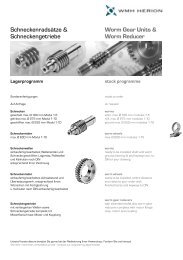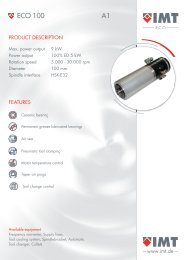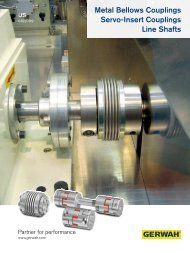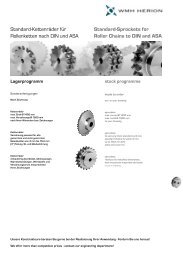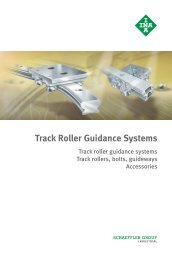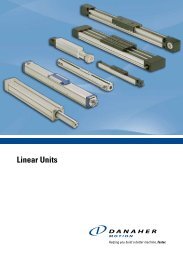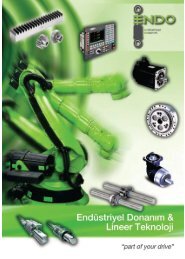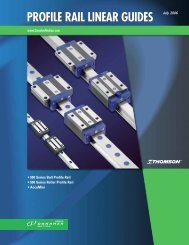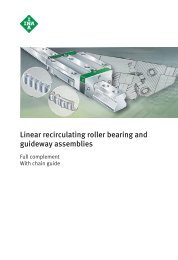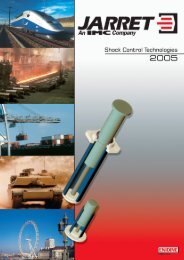slide guide
slide guide
slide guide
Create successful ePaper yourself
Turn your PDF publications into a flip-book with our unique Google optimized e-Paper software.
LINEAR SYSTEM<br />
When the travel distance per unit time is constant,<br />
the rated life can be expressed in terms of time (hour).<br />
Equation (9) shows the relationship between stroke<br />
length, number of cycles per minute, and the life<br />
time.<br />
・Hardness Coefficient (fH)<br />
In the linear system, the <strong>guide</strong> rail or shaft works<br />
as race way of the rolling elements. Therefore,<br />
the hardness of the rail or shaft is an important<br />
factor in determining the rated load. The rated load<br />
decreases as the hardness decrease below 58HRC.<br />
NB products hold appropriate hardness by advanced<br />
heat treatment technology. In case of using the<br />
rail or shaft of insufficient hardness, please take<br />
the hardness coefficient (Figure 1-2) into the life<br />
calculation equation.<br />
・Temperature Coefficient (fT)<br />
In order to give low wear characteristics NB<br />
products are hardened by heat treatment. If the<br />
temperature of the linear system exceeds 100℃,<br />
the hardness is decreased by tempering effect, so<br />
as the rated load decreases. Figure 1-3 shows the<br />
temperature coefficient as hardness changes with<br />
temperature.<br />
・Contact Coefficient (fC)<br />
When more than one bearing is used in close<br />
contact, the contact coefficient should be taken into<br />
consideration due to the variation of products and<br />
the accuracy of the mounting surface. Table 1-2<br />
shows the contact coefficient for life calculation.<br />
・Applied Load Coefficient (fW)<br />
When calculating the applied load, the weight of<br />
the mass, inertial force, moment resulting from<br />
the motion, and the variation with time should be<br />
accurately estimated. However, it is very difficult<br />
to accurately estimate the applied load due to the<br />
existence of numerous variables, including the start/<br />
stop conditions of the reciprocating motion and of<br />
the shock/vibration. Estimation is simplified by using<br />
the values given in Table 1-3.<br />
Lh= L・10 3<br />
2・lS・n1・60 ……………………(9)<br />
Lh: life time(hr) lS: stroke length(m)<br />
n1: number of cycles per minute(cpm)<br />
Figure 1-2 Hardness Coefficient<br />
hardness coefficient<br />
fH<br />
1.0<br />
0.9<br />
0.8<br />
0.7<br />
0.6<br />
0.5<br />
0.4<br />
0.3<br />
0.2<br />
0.1<br />
60 50 40 30 20 10<br />
race way hardness HRC<br />
Figure 1-3 Temperature Coefficient<br />
temperature coefficient<br />
fT<br />
1.0<br />
0.9<br />
0.8<br />
100 110 120 130 140 150<br />
temperature of the linear system C<br />
Table 1-2 Contact Coefficient<br />
number of linear bearings in<br />
close contact on rail/shaft<br />
1<br />
2<br />
3<br />
4<br />
5<br />
Table 1-3 Applied Load Coefficient<br />
operating conditions<br />
loading<br />
no shock and vibration<br />
low shock and vibration<br />
velocity<br />
15 m/min or less<br />
60 m/min or less<br />
high shock and vibration 60 m/min or more<br />
contact coefficient<br />
fC<br />
1.00<br />
0.81<br />
0.72<br />
0.66<br />
0.61<br />
applied load coefficient<br />
fW<br />
1.0〜1.5<br />
1.5〜2.0<br />
2.0〜3.5<br />
Calculation of Applied Load(1)<br />
Tables 1-4 and 1-5 show the formulas of applied load calculation for typical applications.<br />
W: applied load (N) P1 - P4: load applied to linear system (N) X,Y: linear system span (mm)<br />
x, y, l: distance to applied load or to working center of gravity (mm) g: gravitational acceleration (9.8 x 10 3 mm/s 2 )<br />
V: velocity (mm/s) t1: acceleration time (sec) t3: deceleration time (sec)<br />
Table 1-4 Applied Load Calculation (1)<br />
under static conditions or constant velocity motion<br />
2 horizontal axes<br />
2 horizontal axes,<br />
over-hang<br />
2 horizontal axes,<br />
moving axes<br />
condition<br />
y 0<br />
y 0<br />
y 0<br />
P1P3<br />
W<br />
W<br />
W<br />
W<br />
P3<br />
P1<br />
W<br />
P3<br />
P1<br />
X0<br />
P1P3<br />
P3<br />
P1<br />
W<br />
X<br />
P1P3<br />
X<br />
X0=Xmin.〜Xmax.<br />
X<br />
P4<br />
P2<br />
X0<br />
P4<br />
P2<br />
P2P4<br />
P4<br />
P2<br />
Y<br />
P2P4<br />
Y<br />
Y<br />
P2P4<br />
applied load calculation formula<br />
P1= 1 xo yo<br />
W+ W+<br />
4 2X 2Y W<br />
P2= 1 xo yo<br />
W− W+<br />
4 2X 2Y W<br />
P3= 1 xo yo<br />
W+ W−<br />
4 2X 2Y W<br />
P4= 1 xo yo<br />
W− W−<br />
4 2X 2Y W<br />
Note : If the calculation results<br />
in a negative value, the<br />
loading direction is in the<br />
opposite direction.<br />
Eng-5<br />
Eng-6



